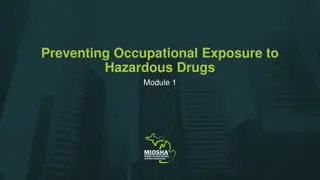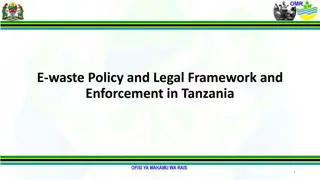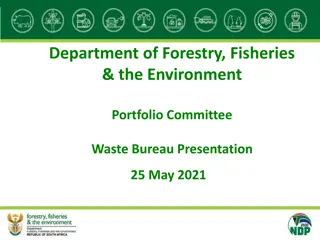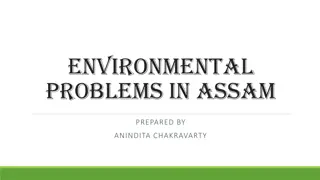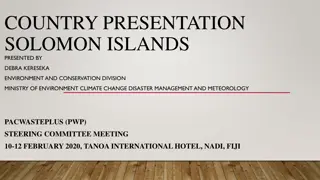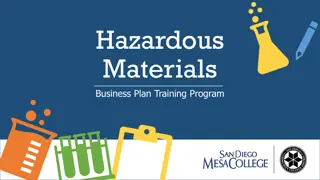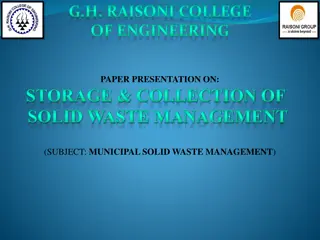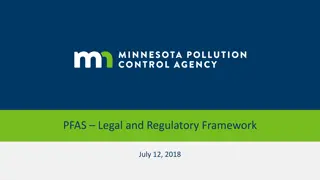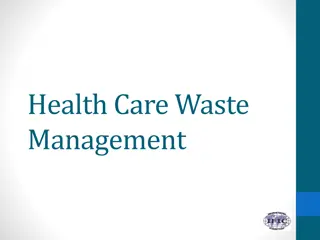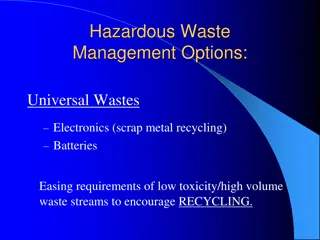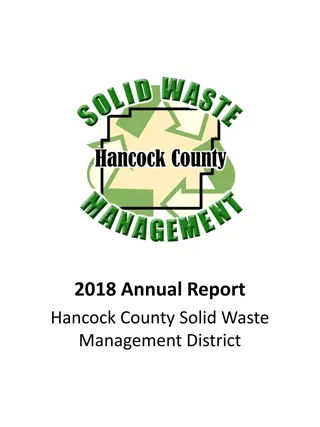Hazardous Waste Management Program Analysis FY 2018-19
This workload analysis examines how the Permitting Division manages resources to meet legislative mandates, track projects, produce outcomes, and mitigate risks in the Hazardous Waste Management Program.
Download Presentation

Please find below an Image/Link to download the presentation.
The content on the website is provided AS IS for your information and personal use only. It may not be sold, licensed, or shared on other websites without obtaining consent from the author.If you encounter any issues during the download, it is possible that the publisher has removed the file from their server.
You are allowed to download the files provided on this website for personal or commercial use, subject to the condition that they are used lawfully. All files are the property of their respective owners.
The content on the website is provided AS IS for your information and personal use only. It may not be sold, licensed, or shared on other websites without obtaining consent from the author.
E N D
Presentation Transcript
1 Hazardous Waste Management Program Permitting Division Workload Analysis for FY 2018-19 October 26, 2020 Prepared by:
2 Slide Intentionally Left Blank SLIDE INTENTIONALLY LEFT BLANK
3 Purpose This workload analysis provides information on how the Permitting Division: Uses its current resources to meet legislative mandates and achieve its mission. Tracks and manages projects to promote efficiency and effectiveness. Produces outcomes to meet its mission. Identifies risks to program performance and effectiveness.
4 Mission Statements DTSC s mission is to protect California s people, communities, and environment from toxic substances, to enhance economic vitality by restoring contaminated land, and to compel manufacturers to make safer consumer products. California Department of Toxic Substances Control Mission Statement The Permitting Division s mission is to protect Californians and the environment from toxic harm by making timely, enforceable, and protective permit decisions for the operation of hazardous waste facilities in accordance with all applicable laws and sound science. Hazardous Waste Management Program Permitting Division Mission Statement
5 To protect Californians, the Permitting Division oversees hazardous waste facilities design and operation (Page 1 of 2) BACKGROUND The Permitting Division (Permitting) in DTSC s Hazardous Waste Management Program (HWMP) makes permitting decisions and oversees operating, closure, and post-closure activities at 103 facilities that treat, store, and dispose of hazardous waste within California. Appropriate decisions and effective permits protect California s residents from hazardous wastes that pose a threat to public health and the environment. Permitting is also tasked with overseeing the adequacy of financial assurance for sites under DTSC s jurisdiction to protect California s residents from toxic harm, and to avoid burdening the California taxpayers with the cost for such efforts. Permitting evaluates every decision regarding the operation of a hazardous waste facility in accordance with the California Environmental Quality Act (CEQA) and performs CEQA analysis to support decisions of other DTSC programs. Permitting also coordinates requests from California government entities to review CEQA documents for hazardous waste impacts related to their projects. Senate Bill (SB) 673 (Lara, Chapter 611, Statutes of 2015) requires DTSC to establish and implement new permitting criteria to improve enforceability, transparency, and equity in permit decisions. Permitting staff led the regulation development and is now implementing 5 new permitting criteria, with support from DTSC s Statewide Enforcement and Legal staff. Permitting is now leading the development of additional SB 673 regulations to establish criteria for consideration of cumulative impacts and community vulnerability in permitting decisions. These SB 673 Track 2 regulations are expected to be promulgated in 2021 for implementation in 2022. Since SB 839 (Committee on Budget and Fiscal Review, Chapter 340, Statutes of 2016) was signed into law, all permit applications received after April 1, 2016 are subject to Fee-for-Service (FFS). DTSC now recovers the cost of reviewing permit applications and making permit decisions. The Permitting Division has undergone transformation in recent years, adopting a culture of continuous improvement, accountability, and improved transparency. Since 2014, DTSC has implemented several process improvements, including permitting enhancements and Lean 6-Sigma (L6S) efforts. L6S projects have reduced the time required to make permit decisions while increasing the quality of application review and permit decisions. The increased efficiency frees Permitting staff to perform more comprehensive and consistent reviews of ongoing permitted activities. Permitting continues to improve by determining the next most significant opportunity to reduce time in its processes without sacrificing quality or public input.
6 To protect Californians, the Permitting Division oversees hazardous waste facilities design and operation (Page 2 of 2) BACKGROUND In 2018-19, Permitting operated with a budget of approximately $13 million and 67.5 positions (63.5 positions were analyzed, as unfunded and executive positions were excluded). Permitting is funded by the Hazardous Waste Control Account (HWCA), Fee-for-Service revenues deposited in HWCA, U.S. EPA Resource Conservation and Recovery Act (RCRA) Grant resources deposited in the Federal Trust Fund, and General Fund. In FY 2018-19 Permitting: Issued 18 permit decisions for renewals, Class 2, and Class 3 permit modifications, many of which are in environmental justice communities. These are communities that are most vulnerable and impacted by multiple sources of pollution. Performed permit maintenance activities, including review of groundwater monitoring reports, air monitoring studies, and closure cost estimates. Reviewed plans, oversaw field activities, and reviewed reports related to closure of 12 facilities. Performed and implemented 4 process improvement initiatives to make the permitting process more efficient, protective, and transparent. Permitting receives its authority from these 3 codes: Code Code Sections Div. 20 Ch. 6.5 25100-25135.9, 25146-25149.7, 25150.82-25150.86, 25152.5- 25155.10, 25159.10-25159.25, 25169.5-25169.8, 25178, 25179.1-25179.12, 25205, 25205.1-25205.23, 25206.1-25206.4, 25208-25208.17, 25209-25209.7, 25220-25227, 25245-25249, 25250-25250.30 Health and Safety (HSC) Public Resources (PRC) Div. 13 21000-21177 Div. 3 Ch. 7 6700-6799 Business and Professions
7 Overview of HWMP s Permitting Division RESOURCES Permitting Division (FY 2018-19) Key Observations DTSC is mandated by statute to: Issue permit decisions for hazardous waste management facilities in California (HSC 25200(a)). Oversee closure of hazardous waste management facilities (HSC 25247). Establish regulations and standards to establish sufficient financial assurance for cleanup and closure at permitted facilities (HSC 25245(a)). Evaluate environmental impacts of discretionary projects in compliance with CEQA (PRC 21000(g)). Adopt permitting criteria to consider facility compliance history among other criteria (HSC 25200.21). Recently, SB 673 required DTSC to evaluate and quantify a facility s compliance history, cumulative impacts, and community vulnerability during a permit decision. Develop and implement programmatic reforms to improve protectiveness, timeliness, legal defensibility, and enforceability of the permitting program (HSC 25200.23). DTSC is authorized to perform 5-year reviews of the estimated costs to implement closure and post-closure activities at permitted facilities. Permitting offices are in Sacramento, Berkeley, and Chatsworth. 6 units within Permitting include dedicated technical project managers and associated support staff. Scientist, Engineer, and Environmental Planner classifications comprise over 81% of the division. SOURCES: DTSC HR NOTES: (1) The number of positions used as the basis for the workload analysis may not align with the 2019-20 Salary and Wages Supplement. Unfunded and other specific positions were not included. Permitting s Financial Responsibility (FR) unit assures that sufficient funds are set aside and available for future closure, post-closure, operations and maintenance, corrective action, and/or liability. The CEQA unit analyzes and mitigates environmental impacts associated with project decisions. (2) Management office includes management and direct reports.
8 Technical classifications are fundamental to Permitting s success RESOURCES Permitting Division Staff Hours1,2 by Classification (FY 2018-19) Key Observations Permitting is primarily staffed with scientists and engineers, whose expertise is necessary to interpret and implement hazardous waste management regulations for permitted facilities. Activities require knowledge of hazardous waste management laws, CEQA, financial assurance, and contaminants as they relate to applications, closures, and technical consultation requests. 81% of hours are completed by the scientist, planner, and engineer classifications. 4% of hours are dedicated to supervisory positions. The Permitting project managers review the design and operation of permitted facilities to identify deficiencies and deviations from the comprehensive permitting standards and requirements. Permitting s analysts and office technicians complete crucial administrative work for the program. This includes supporting permit decisions, inputting and monitoring data management systems, and processing and tracking contracts. SOURCES: DTSC TEMPO Time Data NOTES: (1) TEMPO showed a senior engineering geologist under Permitting s reporting structure in error and has since been corrected. These hours are not included in the chart and totaled 525 hours (including leave). The following slides include these hours. (2) Leave is not included in this chart. Leave, including state and federal holidays, amounts to 19,460 hours.
9 65 percent of division time goes to technical work on permitting projects, CEQA, financial responsibility, consultation and outreach, corrective action and cleanup support, and SB 673 RESOURCES Key Observations Permitting Division Hours1 by Work Category (FY 2018-19) Permitting completes permitting projects, CEQA evaluations, financial responsibility reviews, administrative activities, consultation and outreach, and program development. Approximately 50% of hours support facility permitting activities. This is work from Permitting, CEQA, and FR unit staff dedicated to permit activities, including Permitting unit supervision hours for technical work in permit reviews. DTSC coordination is 15% of hours. Consultation and outreach includes records requests, rulemaking review and development, and data management tasks. 19% of hours are devoted to administrative activities and is time required to maintain operations. Specific tasks include statutorily mandated reforms and L6S projects. SB 673 hours represent the 5 new permitting criteria which updated financial assurance rules, employee training requirements, compliance history evaluation, community involvement profiles, and health risk assessments. SB 673 Track 2 will require review of cumulative impacts to be considered in a permit decision which will place additional demands on Permitting staff. SOURCES: DTSC TEMPO Time Data NOTES: (1) Leave is not shown in this chart. Leave, including state and federal holidays, amounts to 19,460 hours and 16% of hours. Percentages in the chart take leave into account.
10 70 percent of Permitting staff hours are for permitting projects and program development RESOURCES Key Observations Permitting Units Hours1,2 by Work Category (FY 2018-19) The bulk of hours include reviewing applications and operations for compliance with permitting standards and requirements and managing Fee- for-Service (FFS). FFS work includes work on permit applications received after April 1, 2016. DTSC FFS documentation and procedures are required to comply with HSC 25206.1-25206.4 when seeking cost reimbursement for processing applications. 18% of hours were for administrative activities including statutorily mandated training, health and safety compliance, hiring, budget management, database management, strategic planning, staff meetings, and other tasks. 5% of hours represent consultation and outreach, including maintenance of the EnviroStor data management system, developing and delivering training, and consultative work with the HWMP and the public on hazardous waste permitting issues. SB 673 represents 3% of Permitting units hours. After Statewide Enforcement determines violations scoring tiers, Permitting is mandated to implement special facility requirements based on tiers. As SB 673 workload shifts onto Permitting, associated hours are expected to significantly increase. 2% of hours involved corrective action activities and supporting Site Mitigation and Restoration Program (Cleanup) to mitigate risk at a post- closure or closure site per HSC 25247. NOTES: (1) Activity IDs and Project IDs were grouped into larger work categories in collaboration with program staff. (2) Leave is not included in the chart above. Percentages do not include leave.
11 Permitting completed 18 permit decisions in FY 2018-19 RESOURCES Permit Completions by Timeframe1 (FY 2018-19) The permit application process spans multiple years and involves multiple programs. The 5-phase process consists of: Pre-Application Period: DTSC meets with facilities as part of a pre-application meeting and establishes clear expectations for the permitting process. Administrative Review: DTSC uses an Administrative Review Checklist to determine whether each required item is provided in the application, not provided, or not applicable. Technical Review: DTSC uses a Technical Review Checklist to evaluate whether the permit application meets all of the standards for hazardous waste facilities specified in regulation. Public Comment Period: DTSC provides public notice of a draft decision; reviews and considers each comment received during the public comment period; and prepares responses to comments. Permit Decision: DTSC issues a final permit decision, considering all public comments received. On average, permit decisions spanned 2.6 years and required 1,295 staff hours. Prior to process improvements, permit renewal decisions spanned 4.5 years on average. 5 Class 2 modifications were completed during this period. On average, Class 2 modifications spanned 1 year and required 1,136 staff hours. 2 modifications were completed for Phibro-Tech Inc. 3 Class 3 modifications were completed during this period. On average, Class 3 modifications spanned 1.5 years and required 710 staff hours. Permitting completed a total of 10 renewals. The average renewal spanned approximately 2.6 years and required 1,567 staff hours. 1 renewal for a particularly large-scale and complex permit, spanned 5 years and began prior to Lean 6-Sigma initiatives. Hours varied depending on the complexity and specific requirements of each project. NOTES: (1) Project Hours only represent Permitting s work and does not include work completed by other DTSC programs during the application process.
12 Permitting administers permit modifications, oversees closures, performs special projects, and reviews closure cost estimates that are not covered by Fee-for-Service RESOURCES Key Observations Major Permitting Unit Tasks Not Covered by FFS (FY 2018-19) Work not reimbursed by DTSC s FFS revenues includes activities for oversight of facility closures, review and evaluation of reports prepared by permitted facilities to demonstrate ongoing protective operations, and support to Statewide Enforcement. Permitting performed a total of 328 of these major activities in FY 2018-19. Permitting performed 182 permit maintenance tasks. These include review of deliverables submitted to fulfill permit conditions as part of permit maintenance. Permitting completed 38 Class 1 and 9 Class 1* ( class one star ) permit modifications, allowing facilities to make minor modifications to their operations. Class 1 and Class 1* modifications are the simplest of modifications and are not subject to FFS. 40 emergency permits were issued. Facilities request emergency permits to manage waste posing an immediate endangerment to human health or the environment. 12 closures were ongoing during FY 2018-19, with 8 closures completed. Closure oversight is essential so that contamination issues are resolved. 15 5-year financial assurance closure cost reviews were completed to confirm that financial assurance mechanisms were adequate to cover the cost of future cleanup. Permitting personnel completed 18 special projects and have 14 more ongoing, including projects to implement statutorily mandated reforms, evaluate complex industries such as metal shredders, and to develop new regulations to improve protections in vulnerable communities.
13 Permitting s Financial Responsibility unit monitors funding adequacy for facility closure and cleanup activities RESOURCES Financial Responsibility Unit Hours1,2 by Work Category (FY 2018-19) Financial Responsibility Unit Major Outputs (FY 2018-19) The FR unit reviews and monitors $2.5 billion FA mechanisms for approximately 450 sites under DTSC s jurisdiction. Many of these sites have more than 1 mechanism, as reflected in the 600 FA mechanism management tasks shown. FA mechanism management tasks include tracking of annual updates to the mechanisms and logging of receipt and filing of hardcopy FA mechanisms. The FR unit performed 75 technical assistance tasks for DTSC project managers, the regulated community, and financial institutions. The FR unit reviewed 10 FA mechanisms in support of processing permit applications. 61 FA mechanisms were reviewed for Statewide Enforcement as a part of facility compliance inspections. 30 FA mechanisms were reviewed for Cleanup Program projects. 29 FA mechanisms were released. The FR unit also supported 15 special projects for the Permitting Division. The Financial Responsibility (FR) unit reviews and assesses the adequacy of financial assurance mechanisms for Permitting, Statewide Enforcement, and Cleanup. Financial assurance is essential to oversee that adequate resources are available to perform closure and cleanup in a timely manner to protect California s residents from toxic harm. 41% of the FR unit s hours were devoted to core functions of supporting permit decisions, implementing new SB 673 financial assurance (FA) requirements, evaluating financial responsibility, and providing support to Statewide Enforcement and the Cleanup Program. Note that supervisory time in the FR unit includes time spent on technical review of financial analyses performed by staff. 30% of time is spent on administrative functions including time spent logging and filing financial mechanisms for approximately 450 sites. The FR unit receives over 600 documents per year that require administrative and data management tasks. In addition, the supervisor and financial analysts receive general inquiries from facilities which cannot be charged directly to a site. NOTES: (1) Activity IDs were grouped into larger work categories in collaboration with program staff. (2) Leave is not included in the hours above. Percentages do not include leave.
14 Permitting s CEQA unit reviews permit applications and technical consultation projects to CEQA standards RESOURCES CEQA Unit Major Outputs3 (FY 2018-19) CEQA Unit Hours by Work Category1,2 (FY 2018-19) The CEQA unit spends 25% of their hours directly on permit-related projects. This includes analyzing impacts to associated permit decisions, preparing notices of exemption, reviewing CEQA documents from another lead agencies, coordinating pre-application activities, CEQA consultation and Preliminary Environmental Assessment Reports (PEAR), and preparing addendums to CEQA documents. In FY 2018-19, the CEQA unit processed 1,393 requests for DTSC review of CEQA documents as Responsibility Agency (RA) for hazardous waste issues (PRC 21080.3 and 21081.6(c)). 1 Responsibility Agency Comment Letter for Permitting was prepared. 4 permitting projects, prepared by another lead agency, were reviewed. The CEQA unit reviewed 5 rulemakings which resulted in Notice of Exemptions (NOEs). 6 Environmental Data Analyses were prepared, evaluating prior CEQA documents prepared for an activity that is part of a permitting project. The CEQA unit supported 11 pre-application coordination activities on permitting projects. 15 addenda were prepared to support permitting projects. Addenda are prepared to append updated information to existing CEQA documents. 21 NOEs were prepared for permitting decisions (standardized and RCRA permit types). 34 consultations were performed as part of a Preliminary Environmental Assessment review, to support external lead agencies beginning the CEQA process for a project that includes a permitting project. 47 NOEs were prepared to address emergency permits. Approximately 40% of time is devoted to Technical Consultation and Support, including Responsible Agency Comment Form Letters and CEQA document review as responsible agency for hazardous waste issues. As 1 of 2 central CEQA resources units for DTSC, the Permitting CEQA unit devotes 32% of hours to general administrative activities, supervision, and rulemaking activities. 3% is applied to support the RCRA Grant reporting and cleanup efforts. NOTES: (1) Project IDs and Activity IDs were grouped into larger work categories in collaboration with program staff. (2) Leave is not included in the hours above. (3) No Initial Studies, Negative Declarations, Mitigated Negative Declarations, Environmental Impact Reports, Subsequent CEQA Documents, Supplemental Environmental Impact Reports were prepared by Permitting CEQA in FY 2018-19.
15 Process Improvement and Development Permitting transformed the permitting process over the last 6 years, significantly reducing the time to make permit decisions. Permitting undertook critical Lean 6-Sigma projects. The Division developed dashboards, guidance documents, checklists, trainings, and additional materials. Permitting Dashboard as of January 2020
16 The Permitting Division continues improving in all key performance metrics PROCESS IMPROVEMENT SOURCES: DTSC Permitting Dashboard NOTES: (1) As of June 16, 2020 (2) Project outcomes based on current workload
17 Permitting has reduced the time to complete technical reviews by over 40 percent PROCESS IMPROVEMENT Situation Approach Results In FY 2013-2014, Permitting implemented a L6S project aimed at reducing the technical review period in the permitting process so that 90% of all technical reviews will be processed within 13 months. The project identified 6 major root causes of delays in the technical review process: DTSC evaluates whether permit applications meet the standards for hazardous waste facilities specified in regulations. This phase includes reviews by subject matter experts such as geologists, engineers, scientists, toxicologists, and inspectors. As a result of the L6S, Permitting created and implemented a Technical Review Checklist. The checklist reduced review time and established a streamlined, standardized process. In addition, Permitting replaced broad reviews from multiple support staff with more focused and specific reviews. Technical review is a significant portion of the overall permit application processing time. The average technical review period lasted 45 months prior to implementing improvements. Permit application review checklist was underutilized Review of revised applications took longer than initial review The technical review period reduced from 45 months to 25 months, a 44%-time reduction. 60% of labor hours were spent on non-value-added activities 16% were spent on drafting a permit 10% were spent on preparing public notice documents The L6S project suggestions included using a checklist and: Creating permitting guidance documents and writing Notices of Deficiency Revising permitting guidance documents on how to review applications Training SOURCES: California Governor s Office of Business and Economic Development
18 Permitting has reduced Notices of Deficiency per permit application by 50 percent PROCESS IMPROVEMENT Approach Results Situation The Permitting project manager reviews the permit application and identifies deficiencies in the application. These deficiencies are communicated to the facility via a Notice of Deficiency (NOD) document. Prior to 2015, on average, there were 6 NODs per permit decision. In FY 2014-2015, the Permitting Division implemented a Lean 6-Sigma project aimed at reducing the average to 3 NODs per permit decision. 2 critical issues were identified in the NOD process: As a result of the L6S project, the average number of NODs reduced by 50%. The average number of NODs issued per permit decision was reduced from 6 to 3. Reducing the number of NODs reduces technical review time as well. Lack of early guidance to facilities; and Over half of the deficiencies in the application are administrative in nature and are issues of missing information. The L6S project resulted in the following improvements: Provide early guidance to facilities by holding a pre- application meeting. Communicate expectations of permit application at this meeting and provide a copy of the permit completion checklist (agenda and guidance documents created); NOD templates and guidance; and Shortly after issuance of NOD, Permitting project manager is to meet with the applicant to go over comments for improved clarity; agenda and supporting guidance documents were created. SOURCES: California Governor s Office of Business and Economic Development
19 Permitting has reduced the time spent determining the proper CEQA documentation by over 98 percent PROCESS IMPROVEMENT Situation Approach Results A L6S project was completed to reduce the time to complete CEQA document determinations. After implementing improvements, the Permitting Division reduced the duration to complete a CEQA document determination from 228 calendar days to 3 calendar days (over 98% reduction), with the majority of projects being completed in less than 4 hours. Prior to the L6S project, the average time to decide what type of CEQA document to move forward with was 229 days. This delay can affect Permitting goals and performance metrics. Excessive processing time also delays Permitting decisions and increases costs. The project found 2 areas of concern: documents and consultation. Documents issues included ineffective change communication and inefficient consideration of style versus content corrections. Moderate projects had been charging around 200 hours per permit application to produce a determination, so reduction to about 16 hours per permit application results in a savings to the applicant of approximately $34,000 per application. Studies on processing time showed the following: Decision time varied greatly, with a maximum of 1053 days for 1 project During consultation, important forms were not completed and project managers were not kept updated The median was about 127 days To improve, Permitting introduced a working meeting with a standardized agenda to facilitate the decision about which environmental document to use. 10% of decisions were made within 30 calendar days SOURCES: California Governor s Office of Business and Economic Development
20 Permitting is reducing the time to review environmental monitoring reports by 68 percent (in progress) PROCESS IMPROVEMENT Situation Approach Results In FY 2019-20, the Permitting Division began a L6S project aimed at reducing the review time to less than 30 days for 95% of reviews. 2 critical issues were identified as causing the long review times: Facilities submit environmental monitoring reports to comply with their permits. This project is in the implementation phase. The report summary is undergoing internal testing, to be followed by a beta test with select facilities. Information in the monitoring reports is evaluated to identify issues and releases, and to confirm that the permitted sampling and analysis plans are being followed. Long waiting periods in the work request phase; and Full implementation is expected by July 2020. Low priority for the support service groups performing the reviews. The L6S project has started the following improvements: DTSC takes 95 days (median) to review the reports. A report summary to be submitted with the reports; Guidance for Permitting project managers; and Standard letter template for communicating report deficiencies. SOURCES: California Governor s Office of Business and Economic Development
21 Permitting has increased the number of permit decisions processed within 2.5 years PROCESS IMPROVEMENT Key Observations Permit Decision Completions1 Processed in 0-2.5 years The division set an aggressive goal of completing 90% of permit applications within 2 years for renewals and new permits. Permitting has already reduced the average time it takes to make a permit decision from 4.5 years to 2.6 years. The division continues to work towards the 2-year mark while performing more comprehensive permit application reviews and providing increased opportunities for public input. In addition, Permitting improved public accessibility to project documents, reduced the time for CEQA document decisions, implemented intradepartmental efficiencies, and reduced the processing time for tank assessment engineering reviews. These improvements contribute to the success of Permitting s goal of 2-year permit decisions for 90% of permit applications. The percentage of permit decision completions done within 2.5 years increased by 26% since FY 2014-15. 65% of permit decisions were made within 2.5 years in FY 2018-19. Of the 6 completed in over 2.5 years, 4 were completed in 2.7 years. With the addition of new staff and implementation of L6S recommendations, Permitting process times fluctuated, due to incorporating new documents, checklists, and additional process improvements. Beginning FY 2017-18, Permitting processes were more stable and show demonstrable improvement. SOURCES: DTSC Permitting EnviroStor NOTES: (1) Permit decision completions shown include renewals. Class 3 and Class 2 modifications, and new permits
22 Permit decisions for New and Renewal Permits and Class 3 Modifications grew by 550 percent in 5 years PROCESS IMPROVEMENT Key Observations Permit Decisions for New and Renewal Permits and Class 3 Modifications (FY 13/14 FY 18/19) The number of FY 2018-19 permit decisions is 550% higher than in FY 2013-14, reflecting the success of process improvements coupled with additional staff added through BCPs. Permit decisions reflect more comprehensive reviews of facility operations and design plans and embody more enforceable and protective permit provisions. Permit renewal decisions are those made for existing permitted facilities whose permits are due to expire and who must reapply. Of the 4 classifications of permit modifications, Class 3 is for major structural or operational changes. Over the past 3 years, Permitting shows a steady improvement in number of permit decisions per year. Permitting continues to identify new opportunities to improve. SOURCES: DTSC Permitting EnviroStor
23 SB 673 is helping Permitting provide transparency and protect environmental justice communities RISK SB 673 Background In 2015, the Governor signed SB 673 to strengthen protections for public health and the environment at hazardous waste facilities. As part of SB 673, 5 new permitting criteria were added, one of which was the violations scoring procedure. The violations scoring procedure (VSP) strengthens decision- making around the permit decision process by: Establishing an objective scoring process to evaluate the compliance track record of permitted facilities. Facilities are assigned a compliance tier of acceptable, conditionally acceptable, or unacceptable based on violation scores. Calculating and publishing VSP scores annually. Facilities assigned to the conditionally acceptable or unacceptable compliance tiers are subject to either additional conditions or permit denial, revocation, or suspension. DTSC is mandated by statute to develop and implement regulations for new permitting criteria. In FY 2014-15, DTSC conducted a series of stakeholder engagements to address concerns. Stakeholder interviews identified the following: The need to create clear and objective criteria for making permit decisions based on valid standards of performance and risk A clear standard for violations that would lead to denial or revocation The need to document and provide a scorecard of facility attributes to consider in permitting decisions DTSC did not receive resources to implement SB 673 SOURCES: Senate Bill 673, Senate Committee on Environmental Quality, 2015, Violations Scoring Procedure
24 Resources redirected to implement SB 673 have impacted other permit decisions RISK REDUCTION SB 673 VSP Workload Estimate1 Resource Allocation for VSP The permit decision pipeline gets clogged by lack of capacity in other programs and offices on which Permitting relies. The contributions of staff in other programs are critical to the enforceability, defensibility, and transparency of permit decisions. DTSC is unable to make timely permit decisions without sufficient support from these shared services and support programs. On average, Permitting spends approximately 1,295 hours over 2.6 years on a permit decision. Over those 2.6 years, reallocating 2 positions reduces outputs by nearly 3 permit decisions. Permitting works closely with Enforcement so that that hazardous waste facility permits are clear and enforceable. Enforcement is responsible for inspecting permitted facilities to see that they are operating within the terms of their permits and, when necessary, for taking enforcement actions with the help of Legal. In FY 2018-19, Enforcement spent 3,993 hours in support of Permitting. Reallocating positions from Enforcement will diminish their ability to support Permitting. Legal works closely with Permitting so that DTSC issues hazardous waste facility permits that meet statutory and regulatory requirements and are enforceable. The program also represents Permitting in administrative proceedings including permit denials, suspensions, and revocations. In addition, Legal provides support on CEQA as part of the permit decision process. Therefore, reallocation of positions for VSP work from Enforcement will diminish their ability to support Permitting. Implementation of VSP requires effort from Statewide Enforcement (Enforcement), Office of Legal Counsel (Legal), and Permitting, for initial scoring and for response to facility disputes of scores. Enforcement s 4 environmental scientists are responsible for scoring the violations. Permitting will be responsible for implementing special requirements for facilities based on final VSP scores. Legal works with Enforcement and Permitting to provide legal advice regarding whether requirements and conditions are met, to respond to disputes, and to help address violations quickly to protect public health and safety. As DTSC continues to fully implement the requirements of the VSP regulations, public engagement support will be needed that will require additional resources in the Office of Environmental Equity (OEE). More demands will be placed on Permitting staff as a result of the future SB 673 Track 2 permitting criteria for cumulative impacts and community vulnerability, not reflected in the estimate above. These regulations are being developed by Permitting staff and expected to be promulgated in 2021 for implementation in 2022. NOTES: (1) This figure depicts Permitting s resource needs. Resources will be needed in other DTSC programs to support these activities. (2) In FY 2018-19, Statewide Enforcement s 57 inspectors completed 395 inspections, or about 7 inspections per person. If each of the 4 reallocated positions completed 7 inspections, that equates to a loss of 28 inspections. (3) In FY 2018-19, permit decisions spanned 1,295 hours and 2.5 years, on average. This equates to approximately 518 hours per year per permit. Factoring the working hours per staff by 2, dividing by 518 hours and dividing by the permit decision time frame equates to nearly 3 less permit decisions over the course of 2.5 years.
25 The CEQA unit is faced with increased demands to support permit decisions and to fulfill DTSC s role as lead agency for hazardous waste RISK CEQA Document Review Requests New and Renewal Permit and Class 3 Mod. Permit Decisions DTSC is charged with reviewing hazards and hazardous materials impacts in CEQA documents submitted for review by other local governments and other state agencies that seek out DTSC s expertise. These reviews give DTSC a unique and time- sensitive opportunity to assess proposed discretionary projects and make recommendations to prevent or mitigate human and environmental harm. For example, a CEQA document may state that a proposed development is next to a hazardous waste facility. DTSC has the opportunity to review handling of the facilities waste and provide feedback to the lead agency to mitigate risks. Over the last 4 years, requests have doubled due to the State Clearinghouse s new online submission system, an increase in the number of land development projects, and increased understanding of DTSC s role in protecting the environment. The CEQA unit provides a CEQA analysis for each DTSC hazardous waste permit decision.1 From FY 2016-17 to FY 2018-19, Permitting processed a total of 33 permits at an average rate of 11 per year. Over the 3-year period, the number of annual decisions has increased by 2 permits per year. Permitting s CEQA unit is currently allocating 3 staff to supporting permitting decisions, and its current staffing levels are sufficient to address the current Permitting workload. SOURCES: NOTES: State Clearinghouse (1) See CEQA responsibilities in the Permitting process. (2) Estimate for FY 2019-20 based on annualizing current level
26 Increasing levels of CEQA document review requests diminish review periods RISK CEQA Staffing Gap1 Average Review Time/CEQA Document Review (Hrs.) DTSC has been identified by either the lead agency or by the Governor s Office of Planning and Research as a responsible agency to consult on hazardous/ toxic materials pursuant to PRC 21080.3 and 21081.6(c). Increased workload diminishes the unit s ability to meet these mandates. Due to the increased workload, DTSC is not able to provide even the minimal 1.5- hour review of CEQA documents needed to provide critical input on the impacts of hazardous waste on the community and environment. The resulting decisions may lack needed mitigation measures. Current resources allow 30 minutes of review per document. Each 1.5-hour review involves CEQA unit staff and regional liaisons conducting preliminary reviews of each CEQA document s project description, location, and Hazards and Hazardous Materials resource section. Permitting s CEQA unit is currently allocating 1 staff to CEQA document reviews, which provides only about 0.5 hours per CEQA document. To provide minimal level of review requires 2 additional staff. With 2 additional resources, Permitting can provide an estimated 1.5 hours of review to each CEQA document. SOURCES: State Clearinghouse NOTES: (1) This figure only depicts Permitting s resource needs. Resources will be needed in other DTSC programs to support these activities.
27 Conclusion The Permitting Division has undergone transformation in recent years, adopting a culture of continuous improvement, accountability, and improved transparency. Permitting continues to improve by determining the next most significant opportunity to reduce time in its processes without sacrificing quality or public input. The permit decision process timeframe was reduced from 4.5 years to 2.5 years, while increasing the quality of reviews. At the same time, permits are clearer, better supporting compliance, and more enforceable, enabling DTSC to take appropriate action when needed. The number of annual permit renewal decisions have improved from 2 in FY 2013-14 to 13 in FY 2018-19. Permitting also developed a dashboard to provide visibility to staff, leadership, and auditors on key metrics of performance. The Financial Responsibility unit holds and maintains of over 600 financial mechanisms for over 450 facilities/sites, totaling $2.5 billion. In FY 2018-19, this unit received over 600 documents that required administrative and data management tasks and supports other programs such as Statewide Enforcement and the Cleanup Program. The CEQA unit supports permit decisions and reviews CEQA documents for sites that have potential impacts associated with hazards and hazardous materials. Over the last 4 years, requests by local and other state agencies for CEQA reviews have increased by 100 percent. In 2015, Governor Brown signed Senate Bill 673 to strengthen protections for public health and the environment at hazardous waste facilities. As part of SB 673, 5 new permitting criteria were added, one of which was the violations scoring procedure (VSP). DTSC did not receive any additional resources and reallocated existing staff to implement VSP. Coordination with other supporting programs is essential to the permit decision process, and reallocation of resources reduces DTSC s ability to keep making defensible, transparent, and enforceable decisions. Because staff has been reallocated to implement VSP, DTSC is faced with reducing inspections by 28 sites and permit decisions by 3. The workload analysis identified various areas where DTSC has gaps in resources. This presentation showcases 2 of these resource gaps: 2 additional positions would enable the Permitting Division to backfill those resources that were redirected to implement VSP. When new statutes are enacted, Permitting needs resources to fulfill the mandates. Due to the increased workload, DTSC is unable to meet the demand to review CEQA documents submitted by other government entities. This places communities at risk due to lack of complete analysis of potential hazardous waste impacts, and it diminishes the CEQA unit s ability to fulfill its mandates. 2 additional positions would address this resource gap. In addition, new mandates will be placed on Permitting as a result of the future SB 673 permitting criteria for cumulative impacts. This workload analysis did not include any potential resources necessary to implement permitting criteria for cumulative impacts.
28 Contact Information Rizgar Ghazi, P.E. Deputy Director Jane R. Numazu Hazardous Substances Engineer Office of Performance Management and Program Review Department of Toxic Substances Control 1001 I Street Sacramento, CA 95814 Email: Jane.Numazu@dtsc.ca.gov Hazardous Waste Management Program Department of Toxic Substances Control 1001 I Street Sacramento, CA 95814 Email: Rizgar.Ghazi@dtsc.ca.gov

 undefined
undefined







